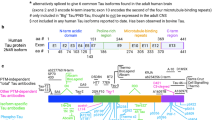Abstract.
The presenilins (PSs) were new proteins discovered in 1995 to be involved, among other functions, in the molecular mechanisms leading to Alzheimer’s disease. These proteins have been the subject of many investigations since then to elucidate their molecular structures and functions. Until now, the conclusions about PS structure have been discordant, but the 8-TM structure has been accepted by the Alzheimer’s community, with the evidence for the 7-TM structure largely ignored. Here the evidence is reviewed for the 6-TM, 7-TM, 8-TM and other proposed models of PS topography and possibilities offered for the differences in interpretation of the various sets of data. The conclusion is that at this stage, the 7-TM model for cell surface PS is most likely the correct one.
Similar content being viewed by others
Author information
Authors and Affiliations
Corresponding author
Additional information
Received 22 December 2004; accepted 26 January 2005
Rights and permissions
About this article
Cite this article
Dewji, N.N. The structure and functions of the presenilins. CMLS, Cell. Mol. Life Sci. 62, 1109–1119 (2005). https://doi.org/10.1007/s00018-005-4566-9
Published:
Issue Date:
DOI: https://doi.org/10.1007/s00018-005-4566-9




